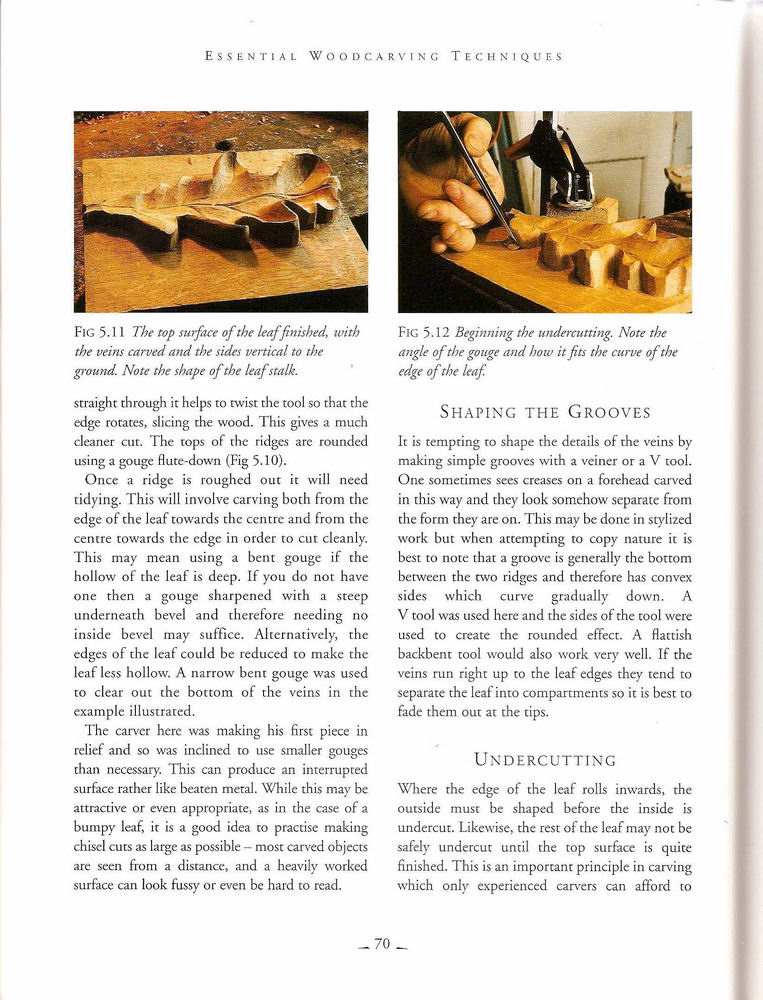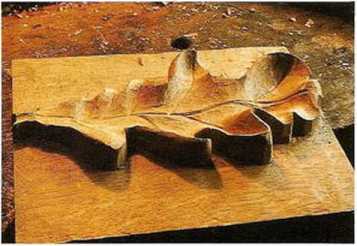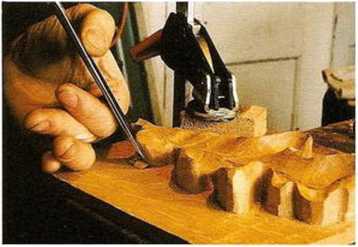essentÊrving°70

Essential Woodcaryinc Techntiques


Fig 5.11 The top surface of the leaffinished, with the ueins carued and the sides oertical to the ground. NotÄ™ the shape of the leafstalk.
srraight through ic helps to twist the tool so that the edge rotates, slicing the wood. This gives a much clcancr cur. The tops of the ridges are rounded using a gouge flute-down (Fig 5.10).
Oncc a ridge is roughed out it will need tidying. This will involve carving both from the edge of che leaf towards the ccntrc and from the centre towards the edge in order to cut cleanly. This may mean using a bent gouge if the hollow of the leaf is deep. If you do not have one then a gouge sharpened with a steep underneath bevel and therefore needing no inside bevcl may suffice. Altcrnativcly, the edges of che leaf could be reduced to make the leaf less hollow. A narrow bent gouge was used to elear out the bottom of the veins in the example illustraccd.
The carvcr herc was making his first piece in relief and so was inclined to use smaller gouges than necessary. This can produce an interrupted surface rather like beaten metal. Whilc this may bc attractive or even appropriate, as in the case of a bumpy leaf, it is a good idea to practise making chiscl cuts as large as possible - most carved objects are scen from a disrancc, and a heavily worked surface can look fussy or even be hard to rcad.
FlG 5.12 Beginning the undercutting. NotÄ™ the angle of the gouge and how it fits the curue of the edge of the leaf
SHAPING THE GROOYES
It is tempting to shape the details of the veins by making simplc grooves with a vciner or a V tool. One sometimes sees crcases on a forehead carved in this way and they look somehow separate from the form they are on. This may be done in stylized work but when atcempting to copy naturÄ™ it is best to notÄ™ that a groovc is generally the bottom between the cwo ridges and therefore has convex sides which curve gradually down. A V tool was used herc and the sides of the tool were used to crcatc the rounded effect. A flattish backbent tool would also work very well. If the veins run righc up to the leaf edges they tend to separate the leaf into compartmcnts so it is best to fade them out ai the tips.
Undercutting
Where rhe edge of the leaf rolls inwards, the outside must be shaped before the inside is undercut. Likewise, the rest of the leaf may not be safely undercut until the top surface is quite finished. This is an important principle in carving which only experienccd carvcrs can afford to
-70 -
Wyszukiwarka
Podobne podstrony:
essent?rving?84 Essential Woodcarving Techniques Fig 7.7 This is how a piece of card would look if f
essent?rving?14 pp Essential Woodcarvixg Techniques W Fig 1.17 Ttoo grounders. Very narrow old Engli
essent?rving?48 Essen tiał Woodcarving Techxiques Fig 3.5 From the bot tom: two correct chip cuts; t
essent?rving?98 Essential Woodcarving Techniques Fig 9.1 Various lines. The one on the left Incks in
essent?rving?24 E S ii E Nil A L W O O O C A R V l N O, T E C H X I Q L F. S Fig 11.14 The left sic
essent?rving?46 ESSF. NTIAL W O O D C A R v I N G T E C H N 1 Q U E S Fig 13.17 Top view afer first
essent?rving?52 Essential Woodcarying Techniques Fig 14.3 Mov mg water. Fig 14.4 Drawings devełoping
Wietrz=F(t,woda) Fig. 3.11 The solubility of aluminium and Silicon as a function of pH. In the shade
76 Rys. 5.II. Stosunek składowych HJHy w funkcji szerokości szczeliny Fig. 5.11. The rełation of HJH
koneksony Fig. 1.11 A ‘ helical wheel’ representation of an amphipathic helix. Each residue is repre
+ X -- Scratching the Surface of Paper Currency with FT-IR Microscopy - Chromium Y
essent?rving?18 Essen tul Woodcarning Techniques Fig 1.29 A bench holdfast in use. Fig 1.28 A univer
essent?rving?30 Essen ti al Woodcarving Techniques Fig 2.4 A piece of Southern yeUow pine. The dark
essent?rving?50 Essen tial W o o d c a r vin g Techniques Fig 3.11 Making the stab aa at too shallow
essent?rving?58 Essen-tial Woodcarvig Techxiques Fig 4.10 Cu tti fig the cup. The gouge en ten the w
essent?rving?66 Essen ti al Woodcarvixg Techniques Fig 5.1 Oak leafstudies by a student (Howard Spie
essent?rving?02 Fig 9.13 Top view of tbe can at an early stage. Fig 9.11 Preparatory drawing of a sq
essent?rving?21 C A R V 1 N G A N Ani M AL IN THE R O l N D Fig 11.5 Rear view. The saw cnts facilit
essent?rving?31 C a r v i n c; i he Humań Figur f. Fic; 12.7 Muscles at the back of the body Fig 12.
więcej podobnych podstron